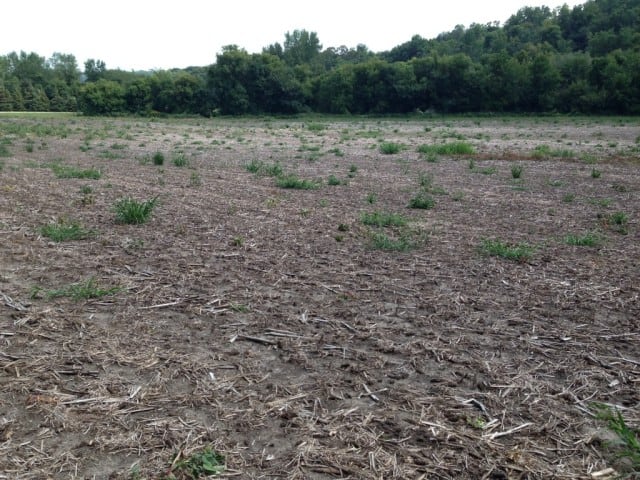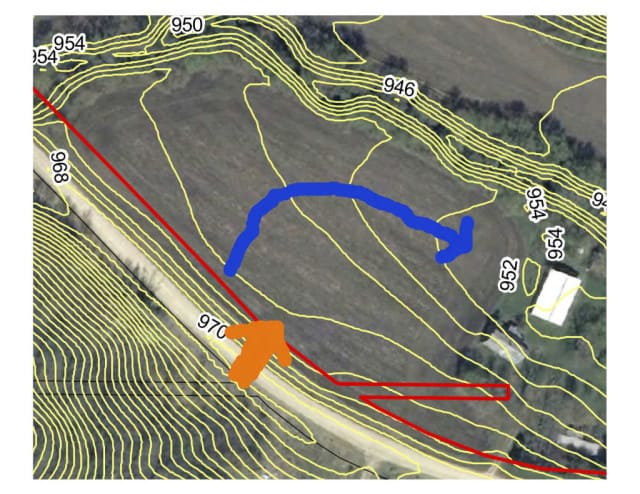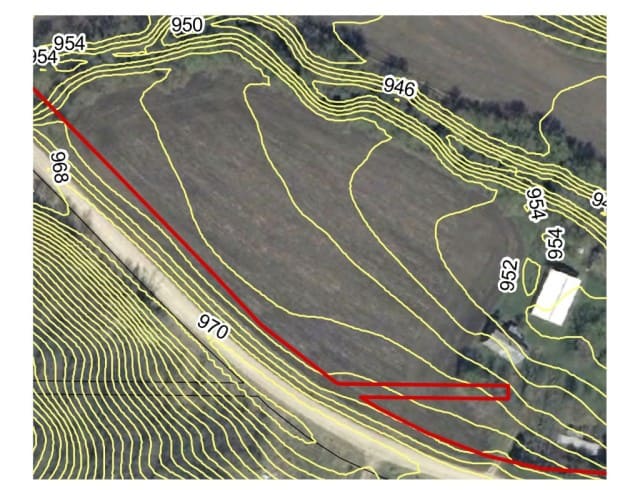The adage ‘Nature abhors a vacuum’ seems true on our farm: disturb the soil and in a few days something will grow – desirable or maybe not. The ‘weeds’ around the strawberries and garlic were pretty awesome this year. . .
 But this image scares the bejbeebers out of me. This is a field on the farm just east of ours which, like many fields in SE MN this year, never got planted because of the wet spring. It’s now the second half of August and what’s growing here? Almost nothing. That’s downright creepy. The years of conventional (likely GM) corn and beans and the chemical cocktail that goes with that have killed the soil. Almost nothing is growing. And there are thousands of acres just like this across Minnesota. What do we think we’re doing?
But this image scares the bejbeebers out of me. This is a field on the farm just east of ours which, like many fields in SE MN this year, never got planted because of the wet spring. It’s now the second half of August and what’s growing here? Almost nothing. That’s downright creepy. The years of conventional (likely GM) corn and beans and the chemical cocktail that goes with that have killed the soil. Almost nothing is growing. And there are thousands of acres just like this across Minnesota. What do we think we’re doing?
Reading "Credit Skills for Lending to the Agricultural Sector" – a report prepared to help Community Development Financial Institutions (CDFIs) understand how to make loans to farm businesses – helped me see how bankers view farmers. Since most farmers need bankers, this prespective is important. And I'm starting to think it's way out of whack.
Briefly, the report argues that to evaluate a farm business as a potential borrower a lender should focus on the things lenders normally consider: the "Five Cs": Character, Capacity, Capital, Collateral, and Conditions. From a lender's standpoint this is typically square one. As the report goes on to flesh out each of these criteria, it implies a set of values and behaviors that a lender should require of a farmer. These include cash flow analysis (broken down by "enterprise" such as poultry, corn, CSA or cheesemaking) and lifestyle expectations (the report casually mentions that 'Farmers generally live a very modest lifestyle, which appears to be well below the poverty line, and they usually have little or no cash fall-back position', an indictment of the place of food and farming in our economy IMHO, but that's an aside). Also required are 'Business Management Skills' and a whole range of skills related to marketing. This goes on in detail for pages.
But I wonder, are these requirements realistic? Reasonable? Appropriate?
A few years back I had a wonderul conversation with Lenny Russo of Heartland Restaurant. He lamented that so many farmers came to him asking what he wanted them to grow. In his mind that was backwards. Lenny wanted farmers to come to him with whatever they grew – but only because no matter the product it was was better than anyone else's. He didn't want to specify what a farmer should grow, he wanted the farmer to use her skill to figure out the best crop for her soil, climate, crop rotation etc. in order to produce a superlative product. Think about what's required to do that. Lenny didn't want good marketing, he wanted good veggies. To grow the best eggplant takes a lot more than a spreadsheet of inputs, outputs and profits, it requires deep understanding and skills that aren't mentioned anywhere in the CDFI report. Great farming that produces the very best products in harmony with the earth requires a vast skill set that bankers don't acknowledge – or possibly even see.
As I read that report, I couldn't help but think that the time and energy required of a farmer to satisfy these loan critera would pretty much exclude any time for actually farming. It's as if the bankers (who are, after all, the high priests of contemporary Euro-American society) and, by default, the rest of us put the cart before the horse: get your numbers right and do all this manangement and accounting stuff then maybe you can do some farming!
I've only been at this a short time, but I'm certain of this: a farmer's knowledge of crops, soil, water, weather, animal husbandry, forestry, conservation, biology and so on is overwhelmingly complex and valuable. And I'd rather have a farmer thinking about how to best sustain the land and produce healthy food than devote hours and hours to a marketing plan.
But that doesn't seem to be how the bankers see it.
Want to help with the farm design? Here’s a challenge for you.
The field immediately west of the farmstead (the one that you see in the header photo) appears flat until you look closely. In fact, it’s a gentle valley channeling water north and then east – straight at the pole shed! That’s why I found four inches of ice in the pole shed last March – and why it filled with topsoil in last summer’s huge rain. As you can see from the contour map, the shape of the land sends water right at the pole shed!
A helpful principle to keep in mind is that water naturally flows at right angles to the contour. The effect of this is to concentrate and channel water along the blue arrow in the second image. In addition, the road acts as a dam collecting water from the hillside to the south. During large rain or runoff events that water is funneled through a culvert indicate with the orange arrow. During ordinary rains and snow melts this culvert doesn’t get any flow, but a serious thunderstorm and – whammo! – big time water rushing onto the field with serious speed and power. (You can see some images from last year’s big rain here.)
So this is the design challenge: what is the best way to construct berms, swales, dams and/or rain gardens to control the water as it moves across this field in order both to minimize topsoil loss and to increase the dwell time, and thus absorption, of the water? At the moment I’m pondering a rain garden at the culvert opening, a swale/berm (to be planted in perennials, but that’s another blog post) somewhere towards the middle of the field and possibly another berm just west of the pole shed to divert any water that does make it that far. But those are general thoughts. If you’d like to have a go at a specific design, please do! I’m open to your ideas. The other factor to keep in mind is that the field will be in alfalfa for the next few years (and may well be used for grazing beyond that time), so access for machinery to cut and bale hay (or for critters in the future) must be included.
Thanks to any budding keyline designers who want to try their hand at this. I hope you enjoy the challenge!
What name can I give to the vision I have of a farm enterprise that is ecologically resilient and economically viable? I’ve been using a string of adjectives to describe the farm(s) I’d like to finance: small-scale, sustainable, diversified, etc. Perhaps I’m overly romantic, but the notion of “family farm” nearly hits the mark – but not quite. This is partly because of land consolidation into industrial farms which may be owned by a ‘farmer’ who tends the enterprise from a computer screen with a keen eye on crop insurance and federal subsidies and where the cash flows are well beyond kitchen table accounting.
On the other side of the coin are the vast majority (numerically, though not in acreage) of farms for many of which the farm income must be supplemented by one or more off-farm jobs. According the the USDA’s Economic Research Service, though 88% of US farms (by number) are considered small (sales of $250,000 per year or less), the remaining 12% of farms produce 84% of agricultural output. They conclude that, “For the most part, large-scale farms are more viable businesses than small family farms” (emphasis in original. Note that the significance of government price supports, crop insurance and the like which disproportionately benefit large farms are not mentioned).
Farming today, at least as reported by the USDA, is concentrated at two ends of a spectrum and what is sometimes called “Agriculture of the Middle” is today relatively rare. Still, I’d like to support efforts towards the idealized “Sweet Spot” I wrote about a while back: farms that can support a family, steward the land and provide safe, healthy food – without relying on off-farm work for income (or health-insurance coverage). Is a family scale farm even possible today? I know there is tremendous creative energy from the National Young Farmers Coalition, the Greenhorns and others. I think they’re going to figure this out.
And I’d like to help.


